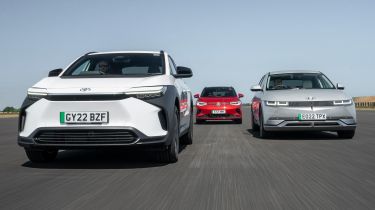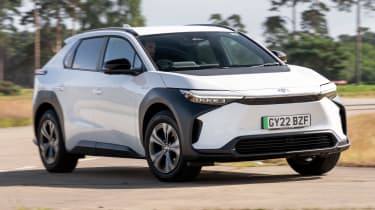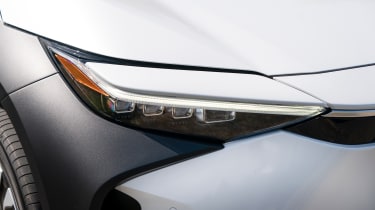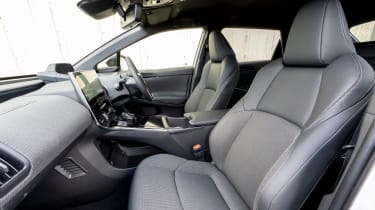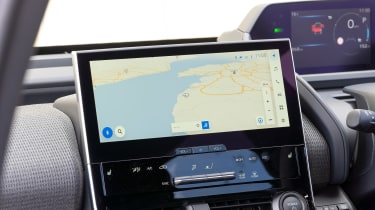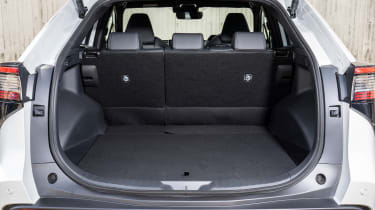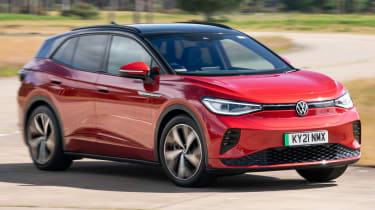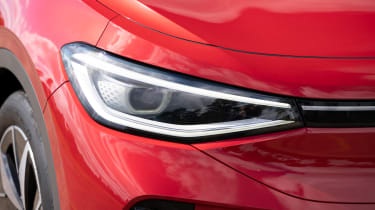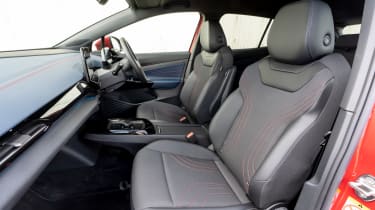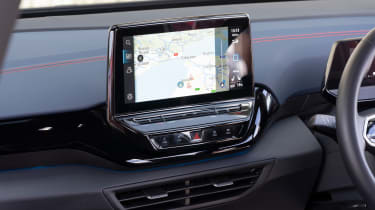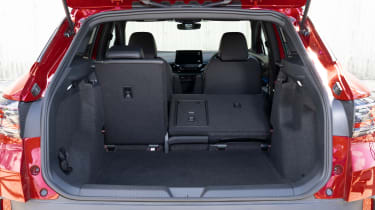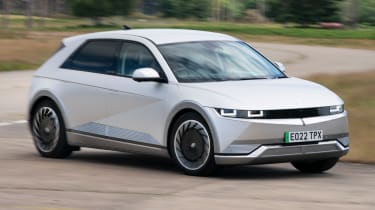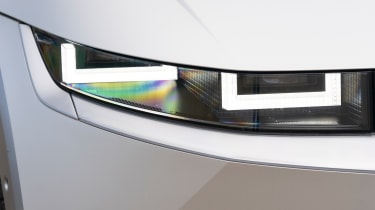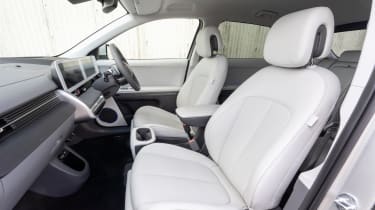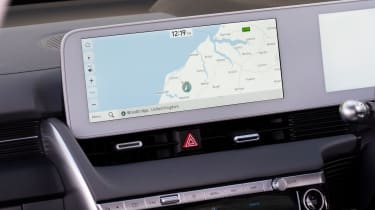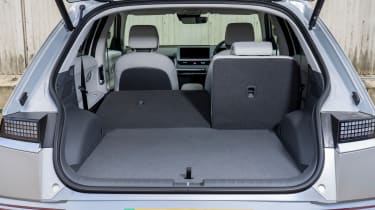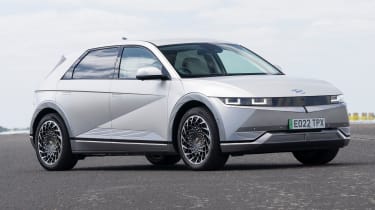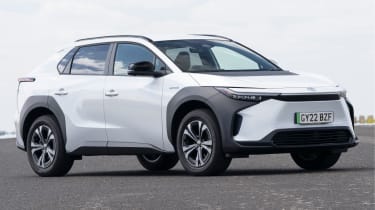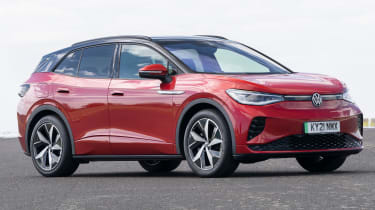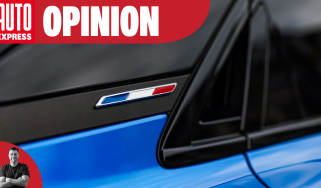Toyota bZ4X vs Volkswagen ID.4 vs Hyundai Ioniq 5: 2022 group test review
Does Toyota’s all-new bZ4X electric SUV crack the family-friendly formula? We compare it to Hyundai and VW rivals
Toyota has been building cars with electric motors for decades. However, it’s not until now that it has diverted from its hybrid focus to produce a model that completely ditches a combustion engine.
This is the bZ4X: an all-electric Toyota that is a rival for the Hyundai Ioniq 5 and Volkswagen ID.4. The bZ4X is joined by its main opponents in this group test. In these trims, each positioned near the top of their respective ranges, all three cars offer just under 300 miles of range at a list price of around £50,000.
Toyota’s foray into EVs won’t be easy. The Ioniq 5 is one of the best electric vehicles you can currently buy, and has already proven itself to be a fantastic car; it’s practical, has future-proofed electric tech, and looks great. It’s the car that the Toyota has to beat here. We’ve brought along an ID.4 in GTX trim for this contest because it matches the specification of the others.
Toyota and VW are the two biggest car makers in the world, so it will be interesting to compare how these companies have approached the challenge of electrification.
Toyota bZ4X
|
Model: |
Toyota bZ4X 160kW AWD Motion |
|
Price: |
£50,180 |
|
Powertrain: |
E-motor/75kWh battery, 215bhp |
|
0-62mph: |
6.9 seconds |
|
Test economy: |
3.4 miles/kWh |
|
CO2: |
0g/km |
|
Annual road tax: |
£0 |
The Toyota bZ4X is an all-electric crossover available with front or four-wheel drive. The former version has a little less power, but all models use the same battery pack. It’s the AWD model we’re testing here, and in Motion trim it costs £50,180.
Used - available now

2023 Lexus
UX
23,495 milesAutomaticPetrol2.0L
Cash £23,825
2022 Land Rover
Range Rover Sport
53,121 milesAutomaticPetrol2.0L
Cash £30,295
2023 Vauxhall
Corsa
32,630 milesManualPetrol1.2L
Cash £11,999
2022 Vauxhall
Grandland
25,817 milesManualPetrol1.2L
Cash £15,790Design & engineering
The bZ4X uses Toyota’s eTNGA platform. As is commonplace with many electric cars, its battery is placed structurally under the floor, which helps keep the centre of gravity low.
This chassis is related to the platform that underpins the RAV4 and C-HR SUVs, so the bZ4X benefits from similar in-car tech and safety systems to those vehicles.
The battery is a 75kWh unit with a usable capacity of 71.4kWh. Choose a front-wheel-drive model, and there’s a single 201bhp electric motor that drives the front wheels, but the AWD model produces 215bhp in total from two electric motors, one on each axle.
Rapid charging is possible at 150kW, which isn’t as fast as the Hyundai’s up-to-220kW capability, but it’s better than the 135kW that the Volkswagen supports. It means you can get an 80 per cent charge into the battery in 32 minutes. Fully charging at a home wallbox takes seven hours and 45 minutes.
Inside, the bZ4X matches the Hyundai for quality, if not flair. It doesn’t have the futuristic design of the Ioniq 5 and feels slightly cramped, but it looks more traditional, it’s easy to use the buttons and dials, and everything feels very well put together.
The only niggle we have is with the steering wheel position; it’s set low, with dials above the rim rather than behind it. Those who have sampled Peugeot’s i-Cockpit layout will find it familiar, but it’s easier for a wider range of body types to get comfortable in the Toyota, even if those with longer legs might still find it a little odd.
Driving
The eTNGA platform’s links to TNGA are really evident when you drive the bZ4X; it feels a lot like a fully electric version of a RAV4 in many ways. That’s a very good thing, because it retains the RAV4’s composure over bumps, so the new EV is one of the most comfortable cars of its type. It’s not by a huge margin, but the Toyota rides more smoothly than both of its rivals here for the most part. There’s still a slight firmness over roads with lots of smaller bumps, but it’s impressive elsewhere, especially on the motorway.
It’s also fun to drive on twisty roads. The steering has a well judged weight, while that relatively forgiving suspension doesn’t produce too much body roll through the corners. The ID.4 GTX has sporty connotations, but even the VW isn’t as controlled or fun as the bZ4X.
The Toyota’s performance isn’t the best, although with 215bhp, it’s still quick enough for most. It takes 6.9 seconds to get from 0-62mph, slower than the Hyundai but only a little behind the VW. All three are typical electric cars in that they feel initially super-quick, but the sense of acceleration tails off at higher speeds.
Toyota worked with Subaru on the car to add an off-road driving mode in this AWD model, but we weren’t able to try it this time. It’s unlikely that this feature will be used much, given that the ground clearance isn’t very high for a model pitched as an SUV. It’s a similar story for its rivals here, too.
Wind and road noise are well suppressed at higher speeds, and the electric motor is as quiet as in the other models, so the Toyota maintains those typical EV traits of refinement and smoothness.
Practicality
One of the first things you might notice about the dashboard of the bZ4X is that there’s no glovebox at all. In fact, in our test car the user manual was simply placed in the small storage spot under the high-set centre console, because there’s no good place for it. It’s a strange omission, but there are some other useful touches, such as a secure wireless phone charging spot, big door bins and a central cubby.
Given that the batteries are under the floor, rear-seat passengers will find that their legs are up in the air – the floor is really high. It’s not the most comfortable position for a long trip, but there’s plenty of legroom and headroom in the new Toyota.
The boot is 452 litres, which is the smallest of the three cars here, 91 litres behind the VW’s 543-litre space. You can fold down the rear seats in the bZ4X, but they don’t go completely flat.
Ownership
Toyota’s reputation for reliability means we have high hopes for the bZ4X. After all, electric cars tend to be even more reliable than piston-powered ones. Even if things don’t go to plan, Toyota’s warranty provides cover for up to 10 years if you have the car maintained at one of its dealers.
Toyota came 10th in the 2022 Driver Power survey, so owners like the brand’s cars, too. Safety is strong as well, because all versions of the bZ4X come with a reversing camera, lane assist, traffic-sign recognition, auto high beams, adaptive cruise control, hill assist, LED lights, parking assist, tyre-pressure warnings, autonomous emergency braking (AEB) and seven airbags.
Running costs
Although the Toyota has the smallest battery pack of the three cars here, so its overall range is lower, it matched both of the other models here for efficiency. Each of our three rivals returned 3.4 miles/kWh, which works out at 243 miles of range in the real world for the bZ4X, 263 miles for the Ioniq 5 and 262 miles for the ID.4.
The Toyota is more expensive to service than the Hyundai, but the residual values - partly because of that long warranty - are very strong and help to make up for that added cost.
Tester’s notes: “Going by the bZ4X’s trip computer, the air-con has a big negative effect on the car’s efficiency, slashing up to 50 miles from the range on a hot day.”
Volkswagen ID.4
|
Model: |
Volkswagen ID.4 GTX |
|
Price: |
£51,580 |
|
Powertrain: |
E-motor/82kWh battery, 295bhp |
|
0-62mph: |
6.2 seconds |
|
Test economy: |
3.4 miles/kWh |
|
CO2: |
0g/km |
|
Annual road tax: |
£0 |
The Volkswagen ID.4 GTX is the top-spec version of the ID.4, and it starts from £51,580. That makes it the most expensive car here, while the model we tested had options to bring that price to £55,175; the Kings Red paint on its own adds £825.
Design & engineering
Under the beefed-up styling of the sportiest ID.4 model is the VW Group’s MEB architecture. As with the Hyundai, it’s a platform that was designed specifically for electric cars from the outset. There’s a 77kWh battery under the floor, which provides a claimed range of 299 miles – although our real-world range of 262 miles means it matches the Hyundai in that area.
The GTX is lowered by 15mm when compared with the standard ID.4 and has an electronic differential lock to help with traction, too. There are drum brakes fitted at the rear, although performance is just fine; the regenerative effects of the electrical system mean you don’t really need discs on the rear, and the fronts are strong enough.
At 2,224kg, the ID.4 is the heaviest model in this group – the Hyundai weighs 2,045kg and the Toyota 2,015kg. All are far heavier than their petrol equivalents because of the batteries on board, but even for an EV, the VW is on the heavy side. This means that it doesn’t make best use of its powerful electric motor, which provides 295bhp and 460Nm of torque.
Charging takes about seven and a half hours from a home wallbox, or half an hour at a public rapid charger (to 80 per cent) that supports the VW’s maximum 125kW charge rate. However, this is the slowest set-up of these three.
One of the biggest let-downs of the ID.4 GTX is the interior, which is dull to look at, uses lower-quality materials than the Toyota or Hyundai and has a frustrating infotainment set-up that looks a generation behind the others. The VW is also not as well equipped as its rivals; there’s no powered tailgate or blind-spot assist as standard, for example.
Driving
The ID.4 GTX has a badge that’s meant to be reminiscent of the brilliant Golf GTI, but it’s really nothing like that car. There’s no more driving involvement to be found here than in any other version of the ID.4 – it’s just a little bit faster. It feels more like a high trim level than a sporty version.
A chunky kerbweight means the GTX will never feel like a Golf GTI in corners, but the ID.4 isn’t even as good to drive as the Toyota bZ4X. While body control is commendably taut, especially considering the car’s weight, the steering is numb and light, so it’s not much fun.
The VW is comfortable, although again the Toyota just edges it in that area. The ID.4 is about the same as the Ioniq 5 over bumps, in that it’s stable and settled on the motorway, but slower, bumpier roads are a weaker point. There’s a 0-62mph time of 6.2 seconds, so the fun part of driving the GTX can be accelerating up to speed. However the Hyundai is even faster, taking 5.1 seconds to do the same. Since you rarely use all of the performance offered by an electric car, even the Toyota’s 6.9-second time is quick enough for the VW not to feel significantly faster in normal driving.
Practicality
Although the driving experience is underwhelming, the ID.4 impresses with its space and practicality. The 543-litre boot is the biggest here, and while there’s quite a high loading lip, it’s a very roomy and useful space.
Fold the seats down and there’s 1,575 litres of capacity in total, which is actually a little behind the Hyundai’s 1,587 litres, but is still a very strong figure.
The back doors open very wide, and when combined with accessible Isofi x points and an SUV ride height, it makes it very easy to install a child seat. For older occupants, the rear seats are comfortable and have lots of leg and headroom.
There are vast door bins up front, while the floating centre console has space for two large cup-holders and a generous covered bin for hiding valuable items. The ID.4 feels more spacious than the Toyota because the centre console isn’t as wide or high, but it’s not as airy or futuristic as the Hyundai. The digital instruments adjust with the steering column, so they’re always in the right place – a clever touch.
Ownership
It was a five-star result for the ID.4 when it was tested by Euro NCAP, and the car earned particularly high scores in the Adult Protection and Safety Assist categories.
Standard kit includes adaptive cruise control, lane-keep assist, a reversing camera and AEB,but you don’t get blind-spot assist as standard a you do on the Toyota or Hyundai.
Volkswagen as a brand did relatively poorly in the 2022 Driver Power customer satisfaction survey, finishing in 18th place. Hyundai was 11th and Toyota was 10th, so the ownership experience is likely to be better with the other models. Plus the VW only has a three-year warranty, at least two years behind the others.
We’d expect reliability to be excellent in all three cars, though, because electric models have less to go wrong than combustion-powered cars.
Running costs
In this summer test we saw 3.4 miles per kWh from the ID.4 GTX, which matched its rivals. However, it’s worth noting that the last time we tested a GTX in colder conditions it returned 2.7mi/kWh. This shows how much difference the weather can make in running an electric car.
Likewise, we found that turning on the air conditioning in hot weather took away range, although the VW lost less than the Toyota, so it seems the ID.4 would be more efficient on a really hot day.
Tester’s notes: “VW has consolidated the window switches on the driver’s door. You need to change their function by pressing the ‘rear’ switch behind them.”
Hyundai Ioniq 5
|
Model: |
Hyundai Ioniq 5 77.4kWh Ultimate AWD |
|
Price: |
£50,450 |
|
Powertrain: |
2x e-motor/77.4kWh battery, 321bhp |
|
0-62mph: |
5.1 seconds |
|
Test economy: |
3.4 miles/kWh |
|
CO2: |
0g/km |
|
Annual road tax: |
£0 |
Auto Express’s 2021 Car of the Year has been treated to some minor tweaks for 2022, with a slightly bigger battery and a rear camera with a feed to the rear-view mirror. The car in our pictures is a rear-wheel-drive model, but to match the other cars in the test, we’ve focused on the AWD here, which starts from £50,450.
Design & engineering
The Ioniq 5 was the first car to arrive using the Hyundai Group’s E-GMP platform, which is designed specifically for electric cars. This set-up positions the battery pack under the floor, like pretty much every purpose-built electric car. The packaging benefits of this layout are most obvious in the Ioniq 5.
Here we’re testing the AWD model, which has 321bhp from its two electric motors. That makes it the most powerful car of the three by a significant margin, even though it’s not the most expensive model and isn’t marketed as a sporty car, unlike the ID.4 GTX.
Recent updates see a new 77.4kWh battery added to the Ioniq 5, up from 73kWh in the first models. Official range doesn’t increase by a huge amount, but there’s a useful 282 miles on the spec sheet.
The battery still uses an 800-volt electrical system that allows faster charging speeds than its rivals here. In the right conditions, this means you can top up the pack from 10-80 per cent in just 17 minutes. This ultra-fast charging is really useful for long trips, and as infrastructure catches up, it will help to future-proof the Hyundai. In comparison, the Toyota can charge at 150kW and the VW at 125kW.
The Hyundai’s interior is excellent, and while it’s not quite as dramatic as the exterior, it captures a similar futuristic look. There’s loads of open space that feels luxurious, the fit and finish are a match for the Toyota’s, and it’s leagues ahead of the VW in terms of design and comfort.
While many new cars sport dark-coloured interiors, the Ioniq is at its best in lighter shades, which are much more in keeping with the contemporary design.
Driving
On the move, the Ioniq 5’s focus on comfort shines through. It’s very easy to drive and while it’s not as sharp as its rivals in corners – it feels a little lazy through the turns and the steering is a bit too light – the Hyundai is ideal for people who just want a comfy cruiser.
It’s settled and composed at higher speeds, so motorway trips are great, but the large alloy wheels and high kerbweight are obvious over bumpier, slower sections, and the Hyundai isn’t as settled as the Toyota, albeit only just behind.
Performance in this AWD version is very strong. The 0-62mph sprint takes just 5.1 seconds, which is more than a second faster than the ID.4 GTX and way ahead of the Toyota. The Ioniq 5’s 321bhp output is more than most hot hatchbacks have; even at higher speeds, there’s enough mid-range power to overtake at a moment’s notice.
The speed doesn’t really suit the relaxed nature of the Ioniq 5, but it’s good to know it has a lot of power at your disposal to get away from junctions. As with its rivals, the Hyundai is ultra-quiet around town and even wind and road noise are hushed at higher speeds.
Practicality
The Hyundai’s clever all-electric architecture, which features a long wheelbase and batteries under the floor, means that there’s loads of space in the cabin. It’s the roomiest car here for passengers, both in the front and the rear.
The airy cabin has loads of foot space because there’s no large, bulky centre console as there is in the Toyota. However, there’s still plenty of interior storage. The rear seats are comfortable and there’s more than enough head and legroom for adults; it’s more spacious than some executive cars. Total boot space demonstrates how roomy the back is – when you fold the seats down, there’s 1,587 litres in total, which is the most here (ahead of the VW, which has 1,575 litres).
The boot is more than big enough with the seats up, though, because there’s 527 litres, although the ID.4 is actually larger in this configuration. One criticism we had of the Ioniq 5 in the past is how dirty the rear screen can get, thanks to the lack of a windscreen wiper, limiting you view. But, order a car today, and you’ll get a model fitted with a camera that feeds live images to the rear-view mirror.
Ownership
EURO NCAP awarded the Hyundai Ioniq 5 a maximum five-star score in its safety tests. It’s helped by generous safety kit such as blind-spot monitoring and cameras, adaptive cruise control, AEB, parking sensors, LED lights and lane-keeping assist. The Ioniq 5 also comes with a five-year warranty as standard, with no mileage limit. This isn’t as long as the Toyota’s potential 10 years of cover, but the fact that there’s no mileage limit means it could be of interest to those who cover large distances.
Running costs
All three cars achieved the same efficiency in our test – a decent, but not stunning, 3.4 miles/kWh. While we haven’t tried a new AWD Ioniq 5 with the latest 77.4kWh battery, both the RWD model in our pictures and the previous AWD version achieved this same figure when tested, so we’re confident the new model will be very close to this, if not the same.
This means annual electricity costs are the same for all three, at about £988 a year to cover 12,000 miles. Company car tax costs are also really similar, because all three are taxed at two per cent for Benefit-in-Kind, which works out at about £400 a year for higher-rate taxpayers – very affordable indeed.
Testers’ notes: “Top-spec Ioniq 5s get ‘relaxation’ front seats. They can recline almost fully, giving a bed-like space in which to chill inside that vast cabin.”
Verdict
First place: Hyundai Ioniq 5
The Ioniq 5 is still one of the most convincing electric cars you can buy. Even if its bold looks haven’t already won you over, there’s a spacious, well equipped cabin, strong performance and great comfort. It’s cheaper than its rivals here while also being better equipped; it has the fastest charging rate, plenty of driving range and slick in-car tech. Overall, it’s a very strong package and one that’s hard to fault.
Second place: Toyota bZ4X
It’s an odd name but the bZ4X is a great car. Its ride and handling balance is the best here, it’s got enough performance for most and has decent charging capability. It’s down on range next to its rivals – albeit only by about 20 miles in the real world – but it’s well equipped, practical enough for family life, easy to drive and has an excellent It runs the Hyundai close, but can’t quite overcome our winner.
Third place: Volkswagen ID.4
The ID.4 GTX is really practical and spacious, plus it’s comfortable and quick, but it falls behind the others here in several key areas. Its cabin doesn’t feel up to
the standard we’d expect of the most expensive car here, and isn’t as well equipped as rivals. It’s also not very exciting to drive, nor is it as fast as the Hyundai. Frustrating infotainment is another reason it can’t compete with the Toyota or Hyundai.
Other options for similar money
NEW: Kia EV6 GT-Line AWD
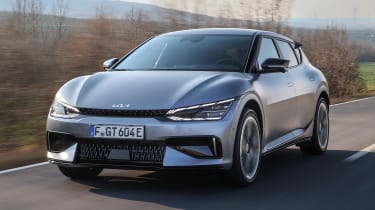
- Price: £50,695
- Battery: 77.4kWh, 314 mile range
The EV6 is even more fun to drive than the Toyota, yet it shares its powertrain with the Hyundai Ioniq 5, so it’s faster than the bZ4X, too. While it’s a great option for a keen driver, it’s not as relaxing as the Hyundai, and it’s not as roomy inside.
USED: Ford Mustang Mach-E 75kWh
- Price: £52,000 (21-reg, 8,000 miles)
The Mach-E is one of the best-driving electric cars you can buy. It’s fast and has superb agility for an electric model, plus it’s well equipped, has a driving range of 248 miles in Standard Range guise, and is practical enough for family needs.
| Hyundai Ioniq 5 77.4kWh Ultimate AWD | Toyota bZ4X 160kW AWD Motion | Volkswagen ID.4 GTX | |
| On the road price/total as tested | £50,450/£51,035 | £50,180/£51,145 | £51,580/£55,175 |
| Residual value (after 3yrs/36,000) | £27,031/53.6% | £29,451/58.7% | £26,522/51.4% |
| Depreciation | £23,419 | £20,729 | £25,058 |
| Annual tax liability std/higher rate | £202/£403 | £193/£386 | £206/£412 |
| Annual elec. cost (12k/20k miles) | £988/£1,647 | £988/£1,647 | £988/£1,647 |
| Insurance group/quote/road tax cost | 34/£861/£0 | 40/£1,102/£0 | 34/£842/£0 |
| Servicing costs | £275 (3yrs) | £620 (3yrs) | £338 (1yr) |
| Length/wheelbase | 4,635/3,000mm | 4,690/2,850mm | 4,584/2,771mm |
| Height/width | 1,605/1,890mm | 1,650/1,860mm | 1,631/1,852mm |
| Powertrain | Electric motor/lithium-ion battery | Electric motor/lithium-ion battery |
Electric motor/lithium-ion battery |
| Peak power | 321bhp | 215bhp | 295bhp |
| Peak torque | N/A | 337Nm | 460Nm |
| Transmission | Single-speed/4WD | Single-speed/4WD | Single-speed/4WD |
| Battery capacity/usable | N/A/77.4kWh | 75/71.4kWh | 82/77kWh |
| Boot capacity (seats up/down) | 527/1,587 litres | 452 litres/N/A | 543/1,575 litres |
| Kerbweight/towing weight | 2,045kg/1,600kg | 2,015kg/750kg | 2,224kg/N/A |
| Turning circle | 12.0 metres | 11.4 metres | 10.2 metres |
| Basic warranty (miles)/recovery | 5 yrs (unlimited)/1yr | 3yrs (60,000)/3yrs | 3 yrs (60,000)/3yrs |
| Driver Power manufacturer/dealer pos. | 11th/15th | 10th/6th | 18th/16th |
| NCAP: Adult/child/ped./assist/stars | 88/86/63/88/5 (2021) | N/A | 93/89/76/85/5 (2021) |
| 0-62mph/top speed | 5.1 secs/114mph | 6.9 secs/99mph | 6.2 secs/112mph |
| Auto Express test economy | 3.4 miles/kWh | 3.4 miles/kWh | 3.4 miles/kWh |
| Auto Express predicted range | 263 miles | 243 miles | 262 miles |
| Claimed range (WLTP) | 282 miles | 286 miles | 299 miles |
| Charging capability | 11kW/50kW/220kW | 11kW/50kW/150kW | 11kW/50kW/135kW |
| Charging time | 6h 9m/56m*/17m* | 7h 45m/70m*/32min* | 7h 30m/71m*/33min* |
| Actual/claimed CO2/tax bracket | 0/0g/km/2% | 0/0g/km/2% | 0/0g/km/2% |
| Airbags/Isofix/parking sensors/cam. | Eight/yes/yes/yes | Seven/yes/yes/yes | Seven/yes/yes/yes |
| Lane keep/blind spot/AEB | Yes/yes/yes | Yes/yes/yes | Yes/no/yes |
| Clim./cruise ctrl/leather/heated seats | Yes/adaptive/yes/yes | Yes/adaptive/no/yes | Yes/adaptive/no/yes |
| Met paint/LEDs/keyless/pwr tailgate | £585/yes/yes/yes | £645/yes/yes/yes | £825/yes/yes/no |
| Nav/digi dash/DAB/connected apps | Yes/yes/yes/yes | Yes/yes/yes/yes | Yes/yes/yes/yes |
| Wireless charge/CarPlay/Android Auto | Yes/yes/yes | Yes/yes/yes | Yes/yes/yes |
